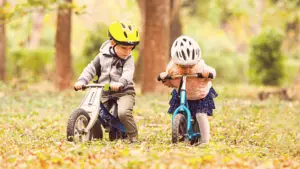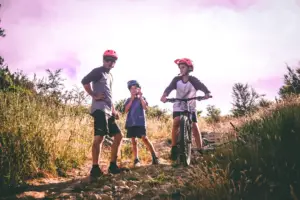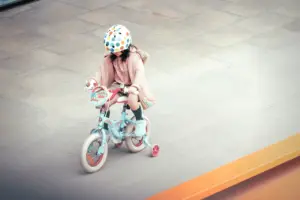Balance bikes and training wheels each have their own sets of pros and cons. The right method depends on factors like your child’s age, coordination level, and personality. This guide examines the key differences between balance bikes and training wheels. Read on to learn which option may be best for your little one.
Teaching Kids to Ride a Bike
Learning to ride a bike brings excitement and confidence. It also builds physical coordination and balance. For many kids, riding a bike represents their first taste of real independence. As they gain this important skill, it’s a milestone moment for the whole family.
The two most common ways to teach children to ride a bike are using a balance bike or a traditional bike with training wheels. Both can effectively help kids learn to balance, steer, and control a bike. The key is choosing the method that best fits your child’s current abilities and temperament.
In recent years, balance bikes have surged in popularity for instilling riding skills in young kids. Yet tried-and-true training wheels still have merit for some children. As we’ll see, each technique has unique benefits depending on the age and coordination level of your child.
Understanding How Balance Bikes Work
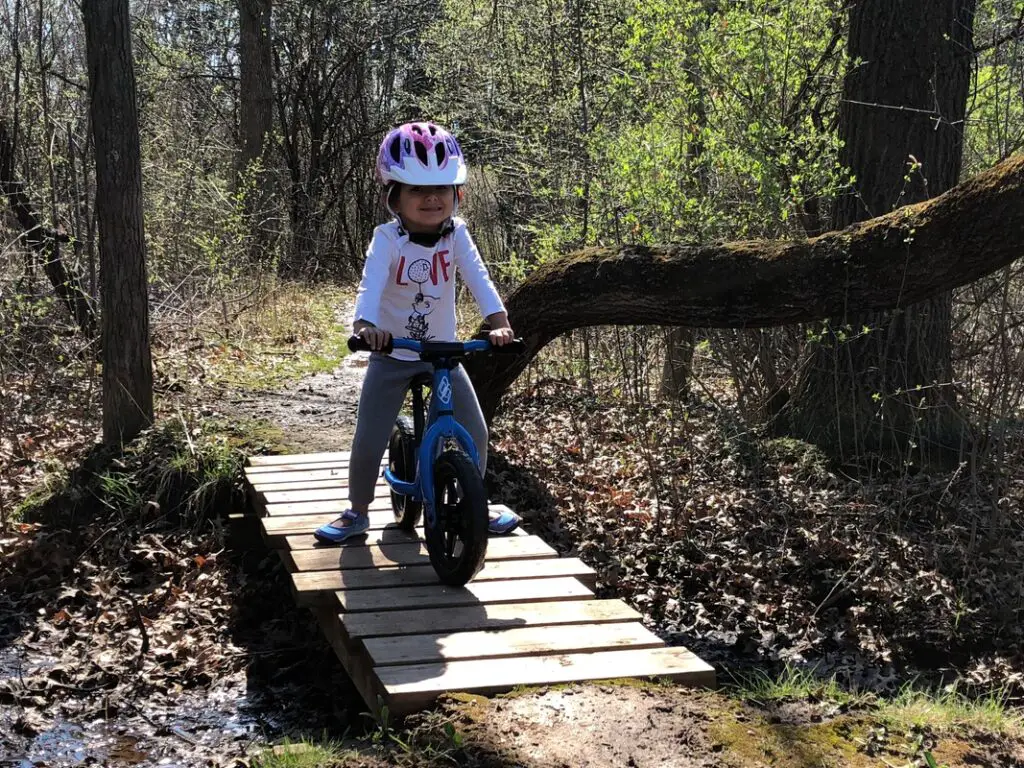
A balance bike, also known as a running bike or “strider bike,” is a bicycle with no pedals. Balance bikes look like regular kid’s bikes, but they are propelled by a child’s feet pushing against the ground. This teaches balance and control before pedaling is introduced.
Balance bikes typically have a seat that adjusts lower to the ground than a traditional pedal bike. They also have proportional wheels and frames for smaller bodies. Many have hand brakes for stopping. The simple design allows kids as young as 18 months old to start riding a balance bike.
Here are some key benefits balance bikes offer for teaching young kids:
- Promote balance and coordination – Balance bikes teach the fundamentals of balancing, steering, and speed control. Kids must use their body position and weight distribution to keep a balance bike upright. This translates directly to pedal bike skills.
- Teach steering – Kids must steer the handlebars to change direction on a balance bike. This ability transfers when they transition to a pedal bike.
- Build confidence – Riding a balance bike shows kids they can balance without relying on training wheels. This instills confidence to eventually ride a regular bike.
- No training wheels needed – Children learn to balance immediately on a balance bike, with no need for stabilizers. This allows for an easier transition to a pedal bike.
In summary, balance bikes let kids get the feel for bicycling without pedals getting in the way. The skills gained build incrementally until they are ready for a pedal bike transition.
The Pros and Cons of Using Balance Bikes
Deciding whether a balance bike is right for your child means weighing the unique advantages against any potential downsides:
Pros of balance bikes:
- Provide a natural transition to pedal bikes
- Teach balance immediately without needing stabilizers
- Help kids learn faster and progress quickly from a young age
- Allow children to touch feet to ground for stability and confidence
- Low seat allows even 18-24 month olds to learn to ride
- Lightweight and easy for children to maneuver
Potential cons of balance bikes:
- Require an extra transition step to a pedal bike
- Higher cost than some training wheel options
- Limited age range as kids outgrow them quickly
- Less initial excitement than a traditional bike with pedals
- Need frequent size adjustments as child grows
As you’ll notice, the pros of balance bikes seem to outweigh the cons for most kids. The only notable drawback is the need to transition to a pedal bike after they’ve mastered balancing. But this extra step is precisely what helps children learn to balance more quickly.
How Training Wheels Can Help Kids Learn to Ride
Training wheels have been used for generations to teach children to ride bicycles. This tried-and-true method is still preferred by many parents today.
Here’s a quick look at what training wheels are and how they work:
- What are training wheels? Training wheels are two small auxiliary wheels attached to the back axle of a children’s bike. This prevents the bike from tipping over to the side during riding.
- How do training wheels help? Training wheels stabilize the bike so children can focus on pedaling without worrying about balance. Kids can build confidence riding on their own.
- Do training wheels teach balance? Training wheels allow kids to ride independently but do not teach balancing skills. Children rely on them for stability. Balance is achieved only once stabilizers are removed.
Some clear benefits training wheels offer include:
- Provide immediate stability so kids can start riding right away
- Allow children as young as 2-3 years old to ride on their own
- Help build pedaling skills and leg coordination
- Offer confidence for cautious kids not ready to balance solo
- Provide a feeling of independence and freedom
For many kids, riding a training wheel bike is exciting since it looks and feels like a “real” bike. The stabilizers minimize fear and falls while building confidence.
The Pros and Cons of Using Training Wheels
Like balance bikes, training wheels come with both advantages and disadvantages to consider:
Pros of training wheels:
- Immediate stability and confidence to ride solo
- Allow developing pedaling motion and leg strength
- No need to transition to a pedal bike
- Familiarity with controls of a standard bike
- Often cheaper than balance bike options
Potential cons of training wheels include:
- Delay development of balance and coordination
- Dependence on stabilizers to avoid tipping
- Falling risk if wheels are set too high
- Difficulty transitioning to unassisted riding
- No ability to learn balance skills
A major downside of training wheels is the delayed development of balance abilities. Kids rely entirely on the wheels for staying upright. Once removed, the bike may feel completely foreign to kids used to stabilizers.
However, for some kids, the pros of training wheels outweigh this drawback. Not all children are ready to balance solo at a young age. Training wheels allow them to participate in bike riding until coordination improves.
Key Factors to Consider When Choosing Between Balance Bikes and Training Wheels
The choice between balance bikes and training wheels depends largely on your specific child. Consider the following factors:
Age – Balance bikes work best for kids 18 months to 5 years old. Training wheels can be used by kids as young as 2 up to 5-6 years old. Fit the method to your child’s current age.
Coordination level – Kids with good balance and motor skills tend to progress faster on balance bikes. Those with less coordination may benefit from training wheels at first. Assess your child’s abilities.
Independence – More adventurous kids often take to balance bikes to independently explore outdoors. Cautious kids may prefer training wheels to boost confidence.
Interest level – Does your child show curiosity about bike riding or are they intimidated? Pick the method that aligns best with their temperament.
Long-term development – Balance bikes build skills that transfer directly to pedal bikes. Training wheels help in the short-term but delay balance abilities.
Also consider your child’s height, inseam length, physical strength, attention span, and patience level. These all impact which teaching method will work best.
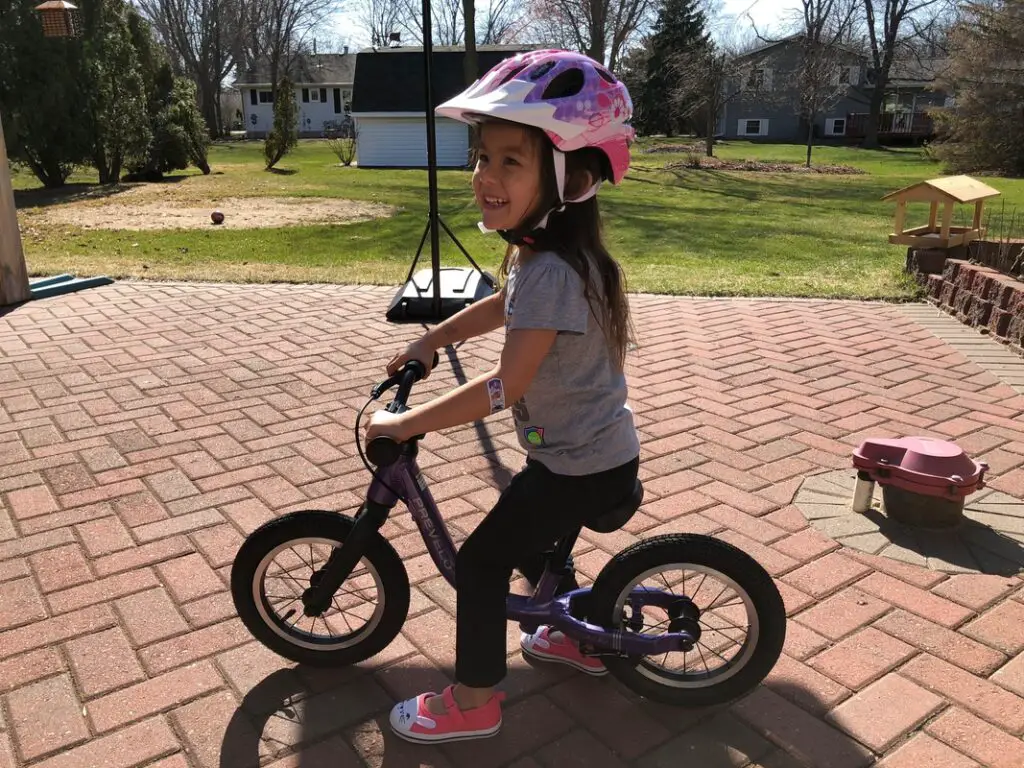
Transitioning from Balance Bikes to Pedal Bikes
One concern parents have with balance bikes is the eventual transition to a pedal bike. Rest assured this process is quite smooth once kids have mastered balancing skills.
Here are some tips for seamlessly moving from a balance bike to pedal bike:
- Start on a pedal bike with the seat set very low. This approximates their balance bike position.
- Keep pedaling optional at first. Let them coast and balance without pedaling.
- Consider removable pedals to make it feel like their familiar balance bike.
- Keep practicing short rides on surfaces with gentle slopes.
- Offer positive reinforcement and praise to spur confidence.
- Move the seat progressively higher as pedaling skills improve.
- Add pedal resistance or brakes slowly so they don’t ride too fast at first.
With patience and encouragement, most kids make the switch from balance bike to pedal bike easily. They apply the balancing skills already mastered. The progression feels natural.
Moving from Training Wheels to Unassisted Riding
Transitioning from training wheels requires more time and practice. Since balance skills are undeveloped, removing stabilizers feels scary and foreign to kids.
Follow these tips to help kids shift from training wheels to big kid bike riding:
- Start by setting training wheel height to the minimum. See if they notice a difference in stability.
- Try short practice sessions without training wheels on soft grass or carpet.
- Consider a small trail bike to make balancing easier when wheels come off.
- Provide reassurance and celebrate small successes to build confidence.
- After removing training wheels, walk beside or behind the bike for support at first.
- Keep practicing short, supervised rides on flat terrain. Avoid hills or inclines.
- Emphasize leaning and steering to help initiate turns and maintain balance.
- Offer praise and don’t rush the process. More falls are likely during this transition.
The transition from training wheels is challenging for many kids. Take it slowly and provide encouragement. Extra patience is required at this stage.
My Thoughts as a Parent: Balance Bike or Training Wheels?

As a parent, I was unsure whether to start my 3-year-old daughter Emilia on a balance bike or a bike with training wheels. She was timid about riding at first. On a friend’s recommendation, I bought Emilia a balance bike to help build her confidence.
Immediately, Emilia loved zooming around on her new balance bike. Within a few weeks, she had mastered balancing, steering and stopping. Most importantly, Emilia learned critical coordination skills right off the bat at such a young age.
When it came time to upgrade to a pedal bike before preschool, the transition was tricky for Emilia. After relying solely on her feet for over a year, pedaling did not come naturally at first. There were some spills and tears during those first few attempts! With patience and encouragement, Emilia eventually got the pedal motion down. Now at age 5, she confidently rides around our neighborhood on her new bike.
In hindsight, starting with a balance bike was ideal for Emilia. She quickly grasped balancing fundamentals, allowing her to focus just on pedaling later. Though learning to pedal took some time, I’m glad we chose a balance bike initially. Emilia gained riding skills far beyond her years thanks to starting on two wheels so early. Her bike handling abilities continue to improve every day.
When it comes down to choosing between starting your child on a balance bike or a training wheel bike, consider their specific needs and abilities.
Here are some final recommendations based on age:
- For children under 3 years old – A balance bike is usually the better choice. Balance bikes allow kids as young as 18 months old to start riding. Training wheels typically aren’t recommended under age 2.
- Kids 3-4 years old – A balance bike is still ideal to start since it teaches balance skills directly transferable to pedal bikes. At this age, balance bikes help develop coordination fast.
- Children 5 years and up – Training wheels are often sufficient if kids have not yet learned to balance. At this point, assess your child’s coordination and interest in learning to ensure training wheels will be beneficial.
No matter which method you choose first, the most important thing is helping your child progress at their own pace. Let their development, confidence level, and preferences guide you. With patience and encouragement, they will be riding solo in no time!


